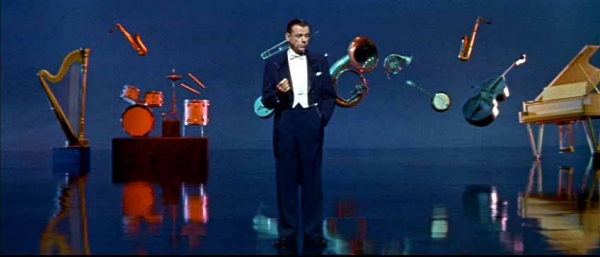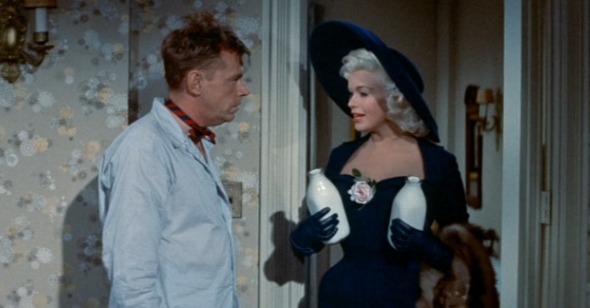The Wide World of Comedy
Eric Kohn on The Girl Can’t Help It
The screwball comedies that enlivened American cinema in the 1930s and 1940s owed much of their humor to irresistibly snappy dialogue and star performances, but far less to the visual landscape surrounding them. By contrast, the playfully suggestive 1950s and early 1960s comedies inverted that formula: they were lovely in appearance but largely sophomoric affairs; from Gentlemen Marry Brunettes to The Tunnel of Love, the dominant offerings of this decade only skimmed the surface of the topics at hand. Frank Tashlin’s movies from this era made for a welcome exception. They celebrated giddy pursuits of happiness while offering portals to deeper possibilities. A former animator, Tashlin was a stylist whose visuals said more than any words could. His movies are shiny toys with hidden sharp edges.
The constraint of 1.37:1—up until recently an industry standard—employed in the opening minutes of Tashlin's The Girl Can't Help It is a subtle ruse: Tashlin foregrounds the prevailing aspect ratio of the era for wry self-reflexivity. Star Tom Ewell saunters into the frame, onto a black-and-white soundstage to introduce this jubilant tale of a small-time theatrical agent, and proclaims that the movie was “photographed in the grandeur of CinemaScope” before trailing off and pardoning himself. As he gently taps the air adjacent to him, the frame’s borders slide apart to reveal a more expansive canvas.
Moments later, Ewell introduces color to the scene with another verbal command. By the end of this opening sequence, he's been drowned out by the bouncy title song, as the camera has ventured away from him to arrive at a close-up of a nearby jukebox. It's a joyful pronouncement of the attitude that will dominate the ensuing 91 minutes, a sharp satire of American consumerism in which the most flavorful ingredients of pop culture get roasted every which way. As we’ve seen, even the elements of cinema itself are ripe for mockery. Tashlin invites us to enjoy the show, but not without constant reminders that it's just that.

“Sometimes you wonder who’s minding the store,” Ewell says in his intro as the frame opens up, and the implications of that statement linger throughout the film, since everything that comes after confronts the essentially manipulative nature of the commercial entertainment industry. The narrative proper starts with Ewell’s character, struggling talent agent Tom Miller, getting hired by two-bit criminal Fatso Murdock (Edmond O'Brien) to elevate his seemingly talentless wife, Jerri Jordan (Jayne Mansfield), to pop stardom. Ewell cajoles Jerri into using her sex appeal to attract record deals from agents around town, and lo and behold, it works—even though, as it turns out, Jerri just wants to be a domestic housewife. Like the arrival of CinemaScope in the opening minutes, that irony offers proof that there's more going on in The Girl Can’t Help It than first meets the eye.
Back to that opening gag: the foregrounding of CinemaScope carries a precise meaning. One of the grandest theatrical gambits of its era, a mere three years old at the time of this movie’s release, CinemaScope was an anamorphic format that emerged at a time of tremendous uncertainty for the future of theatrical exhibition. With the institutionalization of the television in American households at the start of the decade, movies needed to offer experiences unavailable anywhere but on the big screen. These innovations were also a cry for help. To that end, the way CinemaScope is used in The Girl Can't Help It is an explicit acknowledgement of the desperation that drives the industry to innovate—and it’s a similar set of forces that drive poor Tom Miller to make Jerri Jordan an unwitting star.
Even as The Girl Can't Help It celebrates CinemaScope, it also scrutinizes its value. The width of the frame supplies so much room to play around in, but also creates pressure to fill it up. Early on, Tashlin goes intentionally overboard with his colorful frames, which feature rich palettes dominated by soft pink and blue nightclubs offset by black ties and glittery dresses. Every frame is a marvel.
Tashlin’s story keeps pace with a series of surprises, most notably one ingenious tonal shift that finds Tom home alone and haunted by the ghost of his dead lover as her spectral presence sings “Cry Me a River” from every corner of his barren house. Even in a world of candy-coated imagery, with a majestic frame to show it off, the director reveals human frailty lurking beneath the surface. Ewell’s character struggles to make his schemes work from his first scenes, but they mainly unfold in a farcical manner—until we learn that he’s literally living with the ghosts of his past. In this way, CinemaScope—with its promise of exciting, otherworldly thrills—becomes an endearing metaphor for the illusions of an idyllic existence that defined the mythology of the postwar era.
Such tricky tonal maneuvering between dark and light was standard for Tashlin, who gave the advertising world an enthusiastic drubbing with the darkly comic Will Success Spoil Rock Hunter? the following year. His 1955 Dean Martin and Jerry Lewis vehicle Artists and Models explored the tension between the nation's conservative values and the soaring popularity of scandalous comic books. Hollywood or Bust took aim at the fantasies of movie glamour emboldened by the industry. In all of these efforts, Tashlin managed to have it both ways: his visual ebullience went hand in hand with a satire that made it impossible to just relish in the surface entertainment value. In The Girl Can't Help It, that balancing act is maintained in every frame from the moment Ewell opens it up.
CinemaScope also serves another recurring theme in Tashlin’s filmography: an overt interest in sexual humor. Jerri’s ability to constantly wow the men around her manifests in one memorable gag that finds her melting a delivery man’s block of ice as she walks past him. Just as tongues wag for Jerri, Tashlin knows that audiences will swoon for the images encompassed in his expansive frame. The eroticism is embedded in his formalism—or is that just another absurd insinuation about a director whose career has invited constant scrutiny for meanings he never endorsed? As always with Tashlin, The Girl Can’t Help It has it both ways. He invites us in and delivers on our expectations with a constant stream of jubilant sights and sounds—abusing our senses and enlightening us at once.
That state of uncertainty continues through the movie’s remarkable climax, an inversion of assumptions established from the outset. No less than the commandeering ex-gangster Fatso steps up to become a pop star, while Tom and Jerri steal away for domestic bliss. The movie closes with the couple on their honeymoon while Fatso sings from a nearby hotel room TV set. That wonderful screen-within-a-screen conceit brings the multifaceted implications of Ewell's introductory gimmick full circle, back to the smaller, boxy frame of the movie's opener. A film thoroughly in touch with the paradoxes of its time, The Girl Can't Help It thus closes by offering an insightful peek at a future defined by warring formats. In the decades that have passed since the apex of Tashlin’s career, few mainstream American filmmakers have managed to cleverly comment on the technologies of their times while delivering a story that entertains as often as it provokes contemplation.
If a deeper reading of Tashlin's CinemaScope framing stretches his own witty intentions past their snapping point, that itself speaks to the shape-shifting appeal of his exuberant oeuvre. At once unruly and precise in his storytelling techniques, the director hit his targets while running wild with visual gags. The energetic plots found neurotic characters zipping about with marvelously comical results even as their desperation registered on a human scale. Watching Tashlin's widescreen accomplishments, it's easy to see why his legacy hasn't been as celebrated as those of other Hollywood directors—from Howard Hawks to Billy Wilder—who produced work around the same time. His movies' appeal, epitomized by The Girl Can't Help It, stems from an inspired use of mise-en-scène that suggests abstract expressionism by way of a Road Runner cartoon. As Jean-Luc Godard wrote, Tashlin's work presents "poetic fancies where charm and comic invention alternate in a constant felicity of expression." It follows that their ribald exuberance knows no bounds—least of all the edges of the frame.
The Girl Can’t Help It played Sunday, March 8, 2015 at the Museum of the Moving Image as part of See it Big! High and Wide, a series co-programmed by Reverse Shot and Museum of the Moving Image.
